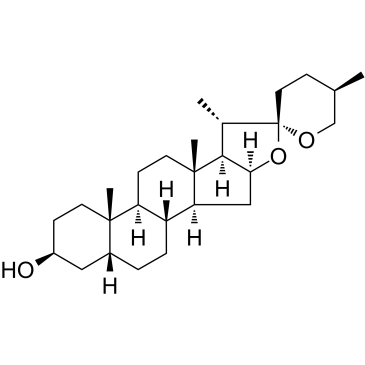smilagenin
Modify Date: 2025-08-25 17:39:22

smilagenin structure
|
Common Name | smilagenin | ||
|---|---|---|---|---|
| CAS Number | 126-18-1 | Molecular Weight | 416.63600 | |
| Density | 1.11g/cm3 | Boiling Point | 516.6ºC at 760mmHg | |
| Molecular Formula | C27H44O3 | Melting Point | -185ºC | |
| MSDS | N/A | Flash Point | 266.2ºC | |
Use of smilageninSmilagenin (SMI) is a lipid-soluble small-molecule steroidal sapogenin from Rhizoma anemarrhenae and Radix asparagi widely used in traditional Chinese medicine for treating chronic neurodegeneration diseases[1]. Smilagenin (SMI) improves memory of aged rats by increasing the muscarinic receptor subtype 1 (M1)-receptor density[2].Smilagenin (SMI) attenuates Aβ(25-35)-induced neurodegenerationvia stimulating the gene expression of brain-derived neurotrophic factor, may represents a novel therapeutic strategy for AD[3]. |
| Name | (25R)-5β-spirostan-3β-ol |
|---|---|
| Synonym | More Synonyms |
| Description | Smilagenin (SMI) is a lipid-soluble small-molecule steroidal sapogenin from Rhizoma anemarrhenae and Radix asparagi widely used in traditional Chinese medicine for treating chronic neurodegeneration diseases[1]. Smilagenin (SMI) improves memory of aged rats by increasing the muscarinic receptor subtype 1 (M1)-receptor density[2].Smilagenin (SMI) attenuates Aβ(25-35)-induced neurodegenerationvia stimulating the gene expression of brain-derived neurotrophic factor, may represents a novel therapeutic strategy for AD[3]. |
|---|---|
| Related Catalog | |
| In Vitro | Smilagenin (10 μM; 24 hours) increases SH-SY5Y cell survival compared with Aβ(25-35) intoxicated cells[3]. Smilagenin (10 μM; 24 hours) increases neurotrophic factor (GDNF) and neurotrophic factor (BDNF) mRNA level by promoting CREB phosphorylation in 1-methyl-4-phenylpyridimium (MPP+) treated SH-SY5Y cells[2]. Cell Viability Assay[3] Cell Line: SH-SY5Y cells Concentration: 10 μM Incubation Time: 24 hours Result: Elevated the SH-SY5Y cell viability. RT-PCR[2] Cell Line: SH-SY5Y cells Concentration: 10 μM Incubation Time: 24 hours Result: Increased GDNF and BDNF transcription. |
| In Vivo | Smilagenin (intragastric administration; 10 or 26 mg/kg, once daily; 60 days) prevents the impairment of dopaminergic neurons in chronic MPTP/probenecid-induced mouse model[2]. Animal Model: MPTP/probenecid-induced mouse model[2] Dosage: 10 or 26 mg/kg Administration: Intragastric administration; 10 or 26 mg/kg; once daily; 60 days Result: Ameliorated locomotor ability of MPTP/probenecid-lesioned mice. |
| References |
| Density | 1.11g/cm3 |
|---|---|
| Boiling Point | 516.6ºC at 760mmHg |
| Melting Point | -185ºC |
| Molecular Formula | C27H44O3 |
| Molecular Weight | 416.63600 |
| Flash Point | 266.2ºC |
| Exact Mass | 416.32900 |
| PSA | 38.69000 |
| LogP | 5.79380 |
| Vapour Pressure | 7.83E-13mmHg at 25°C |
| Index of Refraction | 1.552 |
| Storage condition | 2-8℃ |
| WGK Germany | 3 |
|---|
| (25R)-5beta-spirostan-3beta-ol |
| ISOSARSAPOGENIN |
| (25R)-SPIROSTAN-3BETA-OL |
| SMILAGENIN |
| EINECS 204-775-8 |
| (25R)-Spirostan-3.β.-ol |
| ESMILAGENIN |
| ISOSARSAPOGENINE |
| ISOSARSASAPOGENIN |
| MFCD00037845 |
| 25R,5BETA-SPIROSTAN-3BETA-OL |